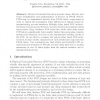Free Online Productivity Tools
i2Speak
i2Symbol
i2OCR
iTex2Img
iWeb2Print
iWeb2Shot
i2Type
iPdf2Split
iPdf2Merge
i2Bopomofo
i2Arabic
i2Style
i2Image
i2PDF
iLatex2Rtf
Sci2ools
ARC
2010
Springer
2010
Springer
An Analysis of Delay Based PUF Implementations on FPGA
Physical Unclonable Functions promise cheap, efficient, and secure identification and authentication of devices. In FPGA devices, PUFs may be instantiated directly from FPGA fabric components in order to exploit the propagation delay differences of signals caused by manufacturing process variations. Multiple delay based PUF architectures have been proposed. However, we have observed inconsistent results among them. Ring Oscillator PUF works fine, while other delay based PUFs show a significantly lower quality. Rather than proposing complex system level solutions, we focus on the fundamental building blocks of the PUF. In our effort to compare the various delay based PUF architectures, we have closely examined how each architecture maps into the FPGA fabric. Our conclusions are that arbiter and butterfly PUF architectures are ill suited for FPGAs, because delay skew due to routing asymmetry is over 10 times higher than the random variation due to manufacturing process.
| Added | 28 May 2010 |
| Updated | 28 May 2010 |
| Type | Conference |
| Year | 2010 |
| Where | ARC |
| Authors | Sergey Morozov, Abhranil Maiti, Patrick Schaumont |
Comments (0)

